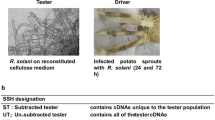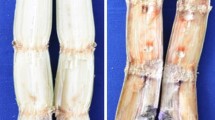Abstract
The wilt defense reaction of cotton is a complicated continuous process and involves a battery of genes. In this study, we adopted the suppression subtractive hybridization (SSH) technique to isolate differentially expressed ESTs from Gossypium barbadense variety 7124 during the Verticillium wilt defense process. An array of 1165 clones from the subtractive library has been screened with reverse northern blotting, of which 131 ESTs were considered as overexpressed and 16 ESTs were downregulated. Sequence analysis and blast search showed that 83 ESTs were homologous to 45 unique sequences in the databases. Among all these differentially expressed ESTs, at least three kinds of genes were characterized. The majority of ESTs with a deduced identity as aerobic metabolism enzymes were strongly expressed in the infection process. Likewise, ESTs similar to those reported for pathogen-related protein genes were also picked out in this study. These ESTs, in combination with other kinase-like genes and a defensin-like EST, constituted an assembly of genes which responded during pathogenic infection. These results imply that sea-island cotton undergoes strong oxidative stress and results in a series of defense responses when attacked by V. dahliae. To our knowledge, this is the first report on the isolation of global ESTs during the sea-island cotton defense reaction.
Similar content being viewed by others
REFERENCES
Garas N.A., Wilhem S., Sagen J.E. 1986. Relationship of cultivar resistance to distribution of Verticillium dahliae in inoculated cotton plants and to growth of single condia on excised stem segments. Phytopathology. 76, 1005–1010.
Daayf F., Nicole M., Geiger J.P. 1995. Differentiation of Verticillium dahliae populations on the basis of vegetative compatibility and pathogenicity on cotton. Eur. J. Plant Pathol. 101, 69–79.
Smit F., Dubery I.A. 1997. Cell wall reinforcement in cotton hypocotyls in response to a Verticillium dahliae elicitor. Phytochemistry. 44, 811–815.
Muller W.C., Morgham A.T., Roberts E.M. 1994. Immuno-cytochemical localization of callose in the vascular tissue of tomato and cotton plants infected with Fusarium oxysporum. Can. J. Bot. 72, 505–509.
Daayf F., Nicole M., Boher B., Pando A., Geiger J.P. 1997. Early vascular defense reactions of cotton roots infected with a defoliating mutant strain of Verticillium dahliae. Eur. J. Plant Pathol. 103, 125–136.
Meyer R., Dubery I.A. 1993. High-affinity binding of a protein-lipopolysaccharide phytotoxin from Verticillium dahliae to cotton membranes. FEBS Lett. 335, 203–209.
Muller W.C., Morgham A.T. 1993. Ultrastructure of the vascular responses of cotton to Verticillium dahliae. Can. J. Bot. 71, 32–36.
Benhamou N. 1995. Ultrastructural and cytochemical aspects of the response of eggplant parenchyma cells in direct contact with Verticillium-infected xylem vessels. Physiol. Mol. Plant Pathol. 46, 321–338.
Bell A.A. 1969. Phytoalexin production and Verticillium wilt resistance in cotton. Phytopathology. 59, 1119–1127.
Garas N.A., Waiss A.C.J. 1996. Differential accumulation and distribution of antifungal sesquiterpenoids in cotton stems inoculated with Verticillium dahliae. Phytopathology. 76, 1011–1017.
Mace M.E., Bell A.A., Stipanovic R.D. 1974. Histochemistry and isolation of gossypol and related terpenoid barriers in the resistance response of a field-resistant and field susceptible potato cultivar to Verticillium dahliae. Physiol. Mol. Plant Pathol. 38, 455–465.
Mace M.E. 1978. Contribution of tylose and terpenoid aldehyde phytoalexins to Verticillium wilt resistance in cotton. Physiol. Plant Pathol. 12, 1–11.
Bell A.A. 1995. Mechanisms of disease resistance in Gossypium species and variation in Verticillium dahliae. In: Challenging the Future. Proc. World Cotton Research Conference-1. Eds. G.A. Constable, N.W. Forrester. Melbourne, Australia: Commonwealth Scientific and Industrial Research Organization, pp. 225–235.
Joost O., Bianchini D., Bell A.A., Benedict C.R., Magill C.W. 1995. Differential induction of 3-hydroxy-3-methylglutaryl CoA reductase in two cotton species following inoculation with Verticillium. Mol. Plant Microb. Interact. 8, 880–885.
Abraham K.J., Pierce M.L., Essenberg M. 1999. The phytoalexins deoxyhemigossypol and hemigossypol are elicited by Xanthomonas in Gossypium cotyledons. Phytochemistry. 52, 829–836.
Mace M.E., Bell A.A., Beckman C.H. 1976. Histochemistry and identification of disease-induced terpenoid aldehydes in Verticillium-wilt resistant and susceptible cottons. Can. J. Bot. 54, 2095–2099.
Mace M.E., Stipanoyic R.D., Bell A.A. 1985. Toxicity and role of terpenoid phytoalexins in Verticillium wilt resistance in cotton. Physiol. Plant Pathol. 26, 209–218.
Jacinda T., Dubery I.A. 2001. Inhibition of polygalacturonase from Verticillium dahliae by a polygalaturonase inhibiting protein from cotton. Phytochemistry. 57, 149–156.
Melissa K.H., Karin J.L., Bruce R.L. 1999. Identification of disease response genes expressed in Gossypium hirsutum. Plant Mol. Biol. 40, 286–296.
Cui Y., Bell A.A., Joost O., Magill C. 2000. Expression of potential defense response genes in cotton. Physiol. Mol. Plant Pathol. 56, 25–31.
Hudspeth R.L., Hobbs S.L., Anderson D.M., Grula J.W. 1996. Characterization and expression of chitinase and 1,3-beta-glucanase in cotton. Plant Mol. Biol. 31, 911–916.
Zhou X., Lu S., Xu Y., Wang J., Chen X. 2002. A cotton cDNA (GaPR-10) encoding a pathogenesis-related 10 protein with in vitro ribonuclease activity. Plant Sci. 162, 629–636.
Dubery I.A., Smit F. 1994. Phenylalanine ammonialyase from cotton hypocotyls: Properties of the enzyme induced by a Verticillium dahliae phytotoxin. Biochem. Biophys. Acta-Protein Struct. Mol. Enzymol. 12, 24–30.
Zhang S., Klessig D.F. 2001. MAPK cascades in plant defense signaling. Trends Plant Sci. 6, 520–527.
Diachenko L., Lau Y.F.C., Campbell A., Chenchik A., Moqadam F., Huang F., Lukyanov K., Lukyanov S., Gurskaya N., Sverdlov E., Siebert P. 1996. Suppression subtractive hybridization: A method for generating differentially regulated or tissue-specific cDNA probes and libraries. Proc. Natl. Acad. Sci. USA. 93, 6025–6030.
Paul A.N., Michele M.M. 2002. Sequential subtractive approach facilitates identification of differentially expressed genes. Plant Physiol. Biochem. 40, 307–312.
Kenneth C.S., William E.G. 1999. A root-injection method to assess Verticillium wilt resistance of peppermint (Mentha piperita L.) and its use in identifying resistant somaclones of cv. Black Mitcham. Euphytica. 106, 223–230.
Qi J., Ma G., Zhao L., Liu S. 2000. Study on the heredity of Verticillium wilt resistance of G. barbadense L. Acta Gossypii Sin. 12, 169–171.
Sambrook J., Fritsch E.F., Maniatis T. 1989. Molecular Cloning: A Laboratory Manual, 2nd ed. Cold Spring Harbor, N.Y.: Cold Spring Harbor Laboratory Press.
Desprez T., Amselem J., Caboche M., Hofte H. 1998. Differential gene expression in Arabidopsis monitored using cDNA arrays. Plant J. 14, 643–652.
Ma Z., Wang X., Zhang G., Liu S., Sun J., Liu J. 2002. Genetic studies of Veriticillium wilt resistance among different types of sea-island cottons. Acta Agro. Sin. 26, 315–321.
Harrison N.A., Beckman C.H. 1982. Time/space relationships of colonization and host response in wilt-resistant and wilt-susceptible cotton (Gossypium) cultivars inoculated with Verticillium dahliae and Fusarium oxysporum f.sp. vasinfectum. Physiol. Plant Pathol. 21, 193–207.
Maleck K., Levine A., Eulgem T., Morgan A., Schmid J., Lawton K.A., Dangl K.L., Dietrich R.A. 2000. The transcription of Arabidopsis thaliana during systemic acquired resistance. Nature Genet. 26, 403–410.
Averlianoy A.A., Kornilova V.F., Merliak M.N., Panaiotov C.A. 1980. Possible participation of superoxide anion radicals in the fungi-toxic cotton of the system of peroxidase oxidation of gossyipol mechanism of cotton to Verticillium dahliae. Biol. Control. 8, 77–79.
Davis D., Legendre L., Low P.S., Heinstein P. 1993. Independent elicitation of the oxidative burst and phytoalexin formation in cultural plant cells. Phytochemistry. 32, 607–613.
Ma C., Jian G., Zheng C. 2002. The advances in cotton breeding resistance to Fusarium and Verticillium wilts in China during past fifty years. Scient. Agric. Sin. 35, 308–315.
Grimaud R., Ezraty B., Mitchell J.K., Lafitte D., Briand C., Derrick P.J., Barras F. 2001. Repair of oxidized proteins. J. Biol. Chem. 276, 48915–48920.
Sagi M., Fluhr R. 2001. Superoxide production by plant homologues of the gp91 ph box NADPH oxidase-modulation of activity by calcium and by tobacco mosaic virus infection. Plant Physiol. 126, 1281–1290.
Cheong Y.H., Chang H., Gupta R., Wang X., Zhu T., Luan S. 2002. Transcriptional profiling reveals novel interactions between wounding, pathogen, abiotic stress and hormonal responses in Arabidopsis. Plant Physiol. 129, 661–677.
Kolattukudy P.E., Rogers L.M., Li D., Hwang C.S. 1995. Surface signaling in pathogenesis. Proc. Natl. Acad. Sci. USA. 92, 4080–4087.
Li J.J., Zingensell I., Buchenauer H. 1996. Induction of resistance of cotton plants to Verticillium wilt and of tomato plants to Fusarium with by 3-aminobutyric acid and methyl jasmonate. Plant Diseases Product. 103, 288–299.
Constabel C.P., Ryan C.A. 1998. A survey of wound-and methyl jasmonate-induced leaf polyphenol oxidase in crop plants. Phytochemistry. 47, 507–511.
Author information
Authors and Affiliations
Additional information
__________
From Molekulyarnaya Biologiya, Vol. 39, No. 2, 2005, pp. 214–223.
Original English Text Copyright © 2005 by Zuo, Wang, Wu, Chai, Sun, Tang.
This article was submitted by the authors in English.
Rights and permissions
About this article
Cite this article
Zuo, K., Wang, J., Wu, W. et al. Identification and characterization of differentially expressed ESTs of Gossypium barbadense infected by Verticillium dahliae with suppression subtractive hybridization. Mol Biol 39, 191–199 (2005). https://doi.org/10.1007/s11008-005-0028-6
Received:
Issue Date:
DOI: https://doi.org/10.1007/s11008-005-0028-6




